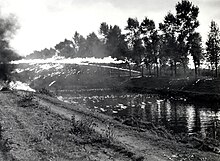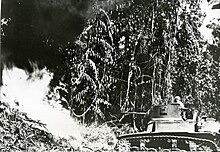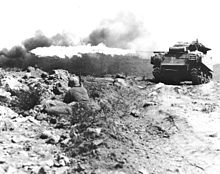
A tank destroyer, tank hunter or tank killer is a type of armoured fighting vehicle, predominantly intended for anti-tank duties. They are typically armed with a direct fire artillery gun, also known as a self-propelled anti-tank gun, or missile launcher, also called an anti-tank missile carrier. The vehicles are designed specifically to engage and destroy enemy tanks, often with limited operational capacities.

The M4 Sherman, officially Medium Tank, M4, was the most widely used medium tank by the United States and Western Allies in World War II. The M4 Sherman proved to be reliable, relatively cheap to produce, and available in great numbers. It was also the basis of several other armored fighting vehicles including self-propelled artillery, tank destroyers, and armored recovery vehicles. Tens of thousands were distributed through the Lend-Lease program to the British Commonwealth and Soviet Union. The tank was named by the British after the American Civil War General William Tecumseh Sherman.

The Panzerkampfwagen III, commonly known as the Panzer III, was a medium tank developed in the 1930s by Germany, and was used extensively in World War II. The official German ordnance designation was Sd.Kfz. 141. It was intended to fight other armoured fighting vehicles and serve alongside and support the similar Panzer IV, which was originally designed for infantry support.

The Panzerkampfwagen IV, commonly known as the Panzer IV, is a German medium tank developed in the late 1930s and used extensively during the Second World War. Its ordnance inventory designation was Sd.Kfz. 161.

The M26 Pershing is a heavy tank/medium tank formerly used by the United States Army. It was used in the last months of World War II during the Invasion of Germany and extensively during the Korean War. The tank was named after General of the Armies John J. Pershing, who led the American Expeditionary Force in Europe in World War I.

The M3 Stuart/light tank M3, was an American light tank of World War II. An improved version of the tank entered service as the M5 in 1942 to be supplied to British and other Commonwealth forces under lend-lease prior to the entry of the U.S. into the war. Afterwards, it was used by U.S. and Allied forces until the end of the war.

The M3 Lee, officially Medium Tank, M3, was an American medium tank used during World War II. The turret was produced in two forms, one for US needs and one modified to British requirements to place the radio next to the commander. In British Commonwealth service, the tank was called by two names: tanks employing US-pattern turrets were called "Lee", named after Confederate general Robert E. Lee, while those with British-pattern turrets were known as "Grant", named after Union general Ulysses S. Grant.

The Panther tank, officially Panzerkampfwagen V Panther with ordnance inventory designation: Sd.Kfz. 171, is a German medium tank of World War II. It was used on the Eastern and Western Fronts from mid-1943 to the end of the war in May 1945.

The M18 Hellcat is a tank destroyer used by the United States Army in World War II and the Korean War. Despite being equipped with the same main gun as some variants of the much larger Sherman tank, the M18 attained a much higher top speed of up to 55 mph (89 km/h) by keeping armor to a minimum, and using the innovative Torqmatic automatic transmission.

Hobart's Funnies is the nickname given to a number of specialist armoured fighting vehicles derived from tanks operated during the Second World War by units of the 79th Armoured Division of the British Army or by specialists from the Royal Engineers.

Nazi Germany developed numerous tank designs used in World War II. In addition to domestic designs, Germany also used various captured and foreign-built tanks.

The 75 mm gun, models M2 to M6, was the standard American medium caliber gun fitted to mobile platforms during World War II. They were primarily mounted on tanks, such as the M3 Lee and M4 Sherman, but one variant was also used as an air-to-ground gun on the B-25 Mitchell medium bomber aircraft. There were five main variants used during the war: M2, M3, M4, M5 and M6.

The M4 Sherman tank was produced in several variants, a result of mass production spread across several manufacturers and several years. It was also the basis for a number of related vehicles and Shermans have been modified by several nations, ranging from upgrades to complete hull conversions for another task. Originally designed in 1941, M4 variants were still used by Israel during the 1967 and 1973 wars with its Arab neighbors.

Tanks were an important weapons system in World War II. Although tanks in the inter-war years were the subject of widespread research, few were made, in just a few countries. However, during World War II, most armies employed tanks, and thousands were built every month. Tank usage, doctrine, and production varied widely among the combatant nations. By war's end, a consensus was forming on tank doctrine and design.

The United States provided tens of thousands of its Medium Tank M4, also named the Sherman, to many of its Allies during the Second World War, under the terms of Lend-Lease.

The 76 mm gun M1 was an American World War II–era tank gun developed by the U.S United States Ordnance Department in 1942 to supplement the 75 mm gun on the basic Medium tank M4. It was also used to arm the M18 Hellcat tank destroyer.
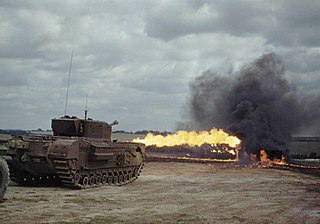
The Churchill Crocodile was a British flame-throwing tank of late Second World War. It was a variant of the Tank, Infantry, Mk IV (A22) Churchill Mark VII, although the Churchill Mark IV was initially chosen to be the base vehicle.
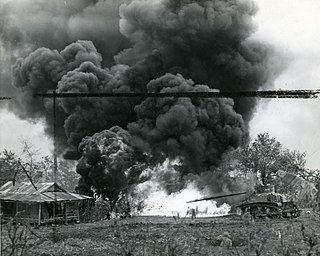
During WWII United States Naval Construction Battalions ("Seabees") modified/created all of the main armament flame throwing tanks that were used in the Pacific War: by USMC in the Battle of Saipan, Battle of Tinian, Battle of Iwo Jima, and by the U.S. Army in the Battle of Okinawa.

When WWII broke the United States had no mechanized flamethrowing capability. It is believed that an officer in the 754th U.S. Army tank battalion came up with the idea of mounting a flame thrower on a M3 Light tank on the island of New Caledonia. The Army used the idea on New Georgia and the Marines during the Battle of Bougainville. After which further development passed to the U.S. Army. Chemical Warfare Service at Schofield Barracks, Territory of Hawaii. There the Army reached out to the United States Naval Construction Force for assistance. The Seabees accepted the offer and converted or modified nearly 400 tanks for the Army. Those weapons set the standard for the U.S. through the Korean War. It was not until 1955 that a superior flame throwing tank replaced the Shermans the Seabees created.


